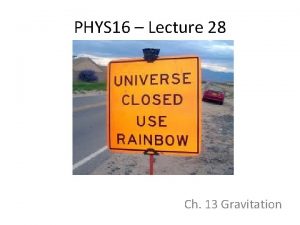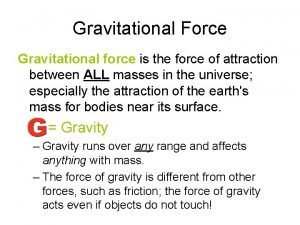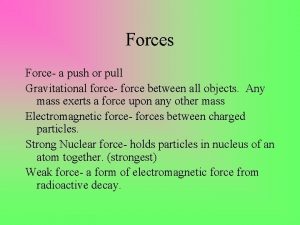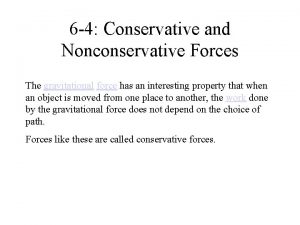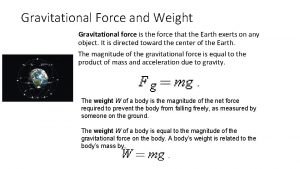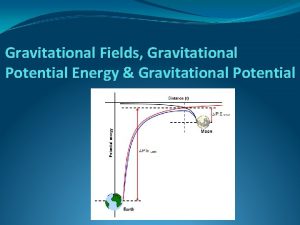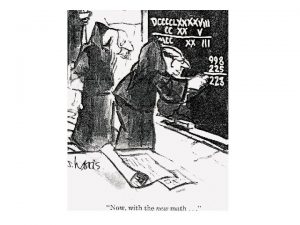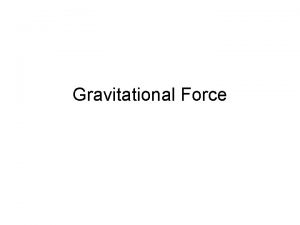Gravitational Force and Weight Gravitational force is the







- Slides: 7

Gravitational Force and Weight Gravitational force is the force that the Earth exerts on any object. It is directed toward the center of the Earth. The magnitude of the gravitational force is equal to the product of mass and acceleration due to gravity. The weight W of a body is the magnitude of the net force required to prevent the body from falling freely, as measured by someone on the ground. The weight W of a body is equal to the magnitude of the gravitational force on the body. A body’s weight is related to the body’s mass by,

4. 8 Types of Forces: In nature there are two general types of forces, fundamental and non-fundamental. Fundamental forces: • Gravitational force • Strong nuclear force • Weak nuclear force-----| • Electromagnetic force--!—The last two are unified…. Electroweak force Non-fundamental forces: Pushing, Pulling, Kicking, Grabbing, etc…. These are related to the electromagnetic force. They arise from the interactions between the electrically charged particles that comprise atoms and molecules. In Everyday life we experience electromagnetic force and gravitational force.

Weak and Strong Nuclear Forces Since the weak and strong nuclear forces act over an extremely short range, the size of a nucleus or less, we do not experience them directly. They are crucial to the very structure of matter. These forces determine which nuclei are stable and which decay, and they are the basis of the release of energy in certain nuclear reactions. Nuclear forces determine not only the stability of nuclei, but also the relative abundance of elements in nature. The properties of the nucleus of an atom determine the number of electrons it has and, thus, indirectly determine the chemistry of the atom.

Fundamental (Basic) Forces Fundamental Force Strong nuclear Example Nucleus Particles Affected Nuclear Relative Range Carrier Strength Particle 1 <10 -15 m Gluon +, - Charges Charged 10 -2 infinity Radioactivity Nuclear 10 -13 <10 -18 m Boson Your weight All 10 -38 infinity (attractive & repulsive) Electromagnetic Photon (attractive & repulsive) Weak nuclear (attractive & repulsive) Gravitational (attractive only) Graviton

Action at a Distance: Concept of a Field

All forces are transmitted by the exchange of elementary particles The exchange of masses resulting in repulsive forces. (a) The person throwing the basketball exerts a force �� p 1 on it toward the other person and feels a reaction force �� B away from the second person. (b) The person catching the basketball exerts a force �� p 2 on it to stop the ball and feels a reaction force ��′ B away from the first person. (c) The analogous exchange of a meson between a proton and a neutron carries the strong nuclear forces �� exch and ��′ exch between them. An attractive force can also be exerted by the exchange of a mass—if person 2 pulled the basketball away from the first person as he tried to

Unification of Fundamental Forces https: //www. youtube. com/watch? v=9 LGBo 7 d. Lg. Yk
